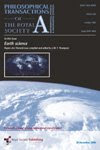Here I shall share a short review of the reference article entitled " An analytical self-consistent determination of a bubble with a deformed cap trapped in solid during solidification [LINK ref. 1] " before it leaves my personal files definitively. By the way most bubbles in liquid steels (liquids including metals and alloys) are so called spherical capped presumably to minimise the energy necessary to create and grow a the new surface Causes Surface_tension_Thermodynamics_of_soap_bubble [Ref. 2] These are subjects with which most Metallurgist,Materials Scientists and Engineers are confronted at some time or other since they occur frequently in materials and manufacturing processes such as casting, welding, and crystal growth. They have a long history, eg. Refs 3 J. D. Fast, Interaction of Metals and Gases, Philips Technical. Library, Eindhoven, 1965, Bruce Chalmers, Principles of Solidification 1964 [Ref4], M.C. Flemings' School at MIT,[Ref.5] (Solidification Processing 1974) Many aspects are still subject to active R and D.
Put simply, gas evolution during solidification is driven by large difference in gas solubility between the liquid and gas phases. Wei's treatment(s) is quit thorough in reviewing previous studies in traditional processes mentioned previously. His mathematical computational approach highlights most if not all parameters involved in defining precisely the shapes of bubbles nucleating during solidification and and remaining entrapped in the resulting solid. Wei claims his methodology is self-consistent, that is, each part logically consistent with the rest, here self-consistency refers to satisfaction of a normal pressure balance outlined in his article and justified by the fact that the ratio Weber N° / Froude N° (We/Fr) <1.
As such his treatment has general applicabity and claims to be in excellant agreement with observed pores in solids (figs 4 to 10 ref.1) He concludes that the pore size is reduced by:
- increasing Bond N° (Bo) defined by - increasing Bond N° (Bo) defined by - increasing Bond N° (Bo) defined as ρ (density) x g (gravity) x ho^2 (total height solid+liquid divided by surface tension σlv between gas-liquid-solid interface = (ρ x g x ho^2) / σlv
- dimensionless parameters governing the gas concentration_Henry's Law-Henry's Constant
- Solidification rate or the displacement of the solidification front (solidifn rate regularity is advantageous)
-decreasing the surounding presure ie head of liquid and applying a vacuum, eg Bulk steel degassing processes and better special posesses uses for very high quality steels and alloys:VIM, VAR, EB. etc.
Wei and co-worker's article (2009) dealing specifically with mainstream-classical welding is freely available at the following undelined link "Bubble Entrapped in Solid during Solidification" [Ref 6]
Welding under vacuum-short of time, I suggest a simple Google search on the fore mentioned key words.
A quite recent rather exautic publication is:
-In 2002, NASA showed interest in gas blowhole defect prone materials and solution calling upon microgravity cf. Toward Understanding Pore Formation and Mobility During Controlled Directional Solidification in a Microgravity Environment (PFMI) [Ref 7]
New - Advanced Processing Applications involving gas bubble formation
In Semi-solid (Thixocasting, Reocasting) gas bubbles are intentionally used for impoved mixing as in many manufacturing especially in high temperature metallurgical processes notably steelmaking.
Ref. 8. Semi-solid Processing of Alloys by David H. Kirkwood,Michel Suéry,Plato Kapranos,Helen V. Atkinson,Kenneth P. Young 2009
Refs 9. Foam Alloys
9.1 Early rimming steels have long evolved to todays field of foam alloys cf. for example Manufacturing Routes for Metallic Foams by John Banhart, JOM, 52 (12) (2000), pp. 22-27
9.2 METAL FOAMS – MANUFACTURE AND PHYSICS OF FOAMING_2005_01_03_Babcsan et al[pdf]
9.3 Dave Curran's home page - Metal Foams- Studied while at Cambridge Univ. UK.
10. Nanobubbles and Nanopores
10.aThermodynamic and Kinetic Stability of Nanobubbles at the Water-Solid Interface: A Modeling and Atomi force Microscopy (AFM) Study
10b. Highly nanoporous surfaces were observed on the underside of Ni splats shows
potential for the manufacturing of high-surface area materials using thermal spray say Meng Qu and Andrew Gouldstone in their paper entitled
" On the Role of Bubbles in Metallic Splat Nanopores and Adhesion " Journal of Thermal Spray Technology
OTHER POSTS:
Surface chemistry: A close look at hydrophobicity_Wetting_non-Wetting_Bulk Steelmaking Macro to Nanotechnology and Biomimicry
All My Pages
Where my visitors are
A380's TRENT XWB
Materials Science and Engineering, Durable Development, Recycling..

Custom Search
Blog List-Free Science and Engineering Information Resources cf also Side and Bottom menu bars
-
-
Research Headlines - Motoarele cu ardere internă au un viitor luminos datorită aprinderii cu laser - [image: Image]Până să devină practice și tuturor accesibile mașinile electrice și alte inovații energetice, va mai fi larg folosit motorul cu ardere, rezul...3 years ago
-
Research Headlines - Inteligentne miasta zorientowane na obywateli - [image: Image]Dzięki technologiom IT usługi miejskie mogą być bardziej wydajne, dostępne i przyjazne dla środowiska. By takie rozwiązania były efektywne, m...3 years ago
-
Research Headlines - En route to safer, more reliable autonomous driving - [image: Image]The development of autonomous driving systems is currently a focus of research for the automotive industry. An EU-funded project has moved wo...3 years ago
-
Instant Inflation Systems for Stand-Up Paddle Boards - Inflatable Stand-Up Paddles (SUP) have provided great flexibility to enthusiasts and allowed the sport to grow in popularity. However, manually or electr...5 years ago
-
The List of Online and Free Access Journals about Metallurgy , Mining - The List of Online and Free Access Journals about Metallurgy and Mining RKOJ = Related Keywords of the Journal Open Mineral Processing Journal RKOJ: ...14 years ago
-
-
Scientific Reports - nature.com science feeds
Physical sciences : nature.com subject feeds
Materials science : nature.com subject feeds
Showing posts with label Thixo-casting. Show all posts
Showing posts with label Thixo-casting. Show all posts
Subscribe to:
Posts (Atom)










